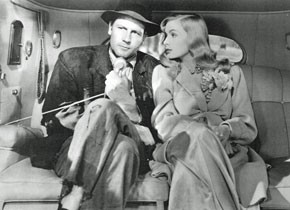Preston Sturges
Seven Films. 1940-44
February 10 to March 7, 2012
Very few U.S. films are as decidedly American as the comedies of Preston Sturges. Their temperament is American (pace and sweeping ideas are more important to them than tact and tastefulness). Their dialogue is American, as pointed and playful in the use of national idioms as the travel writings of Mark Twain. And even the director’s career was “American”, in its sudden rise and quick descent, much like the lives of the everymen who stumble through films like Christmas in July (1940) and Hail the Conquering Hero (1944).
Preston Sturges (1898-1959) – screenwriter, part-time inventor and would-be entrepreneur – was past forty when he staked his claim as a complete auteur. The Great McGinty (1940), a lesson on the benefits of corruption, was a surprise success and showed Sturges' idiosyncratic blend of biting satire and rowdy slapstick. It was the first in an amazing series: within four years, Sturges delivered one shimmering, multi-layered comedy after another, before he fell out of favor with audiences and the studios.
Sturges consistently worked with established genre tropes and character types. With The Lady Eve (1941), he set an elegantly high mark for the screwball comedy cycle, and then brought the form to rousing absurdity with The Palm Beach Story (1942). At the same time, his movies cast an unabashedly direct look at daily life in the U.S. with its enormous promises of happiness alongside extremely rigid constraints. The films deal with low-ranking employees hoping to hit the jackpot (Christmas in July), mass poverty and dislocation (Sullivan's Travels, 1941), and the hysteria of home front patriotism during World War II (Hail the Conquering Hero). In 1944, casting scorn at any considerations of censorship, even the plight of a teenage girl impregnated by a stranger (who is also a solider) became the starting point for dizzyingly comic confusion: "The Miracle of Morgan's Creek is like taking a nun on a roller coaster," noted critic James Agee, delighted with this pinnacle of Sturgian audacity.
The transition from screenwriter to director of his own material, which Sturges tenaciously fought for, set a precedent in the early 1940s for other studio writers like Billy Wilder and John Huston. But even though Sturges wrote nearly all of his films alone, they owe their unmistakable signature to a group: a cast of two dozen gifted character actors who form a basso continuo from film to film, and who often push the nominal "leads" to the side. Just as John Ford returned to Monument Valley again and again, Sturges repeatedly revels in the facial landscapes of his regular acting troupe – the fury-furrowed forehead of William Demarest, the jowls of Franklin Pangborn, the turtle-neck of Jimmy Conlin. With this lineup of talent, Sturges also reached back towards tradition: many of his regulars were trained in the elastic ensemble acting style of 1930s cinema, which he elevated to a higher level. Some of his actors had already worked in the silent era, and Sturges placed their exuberant talent for slapstick on equal footing with wit and sophistication.
The movements of his minor characters and their verbal exchanges aredecisive features of the Sturges style: chaotic and brilliantly orchestrated at the same time, these images and sounds serve as allegories of his restless energy as a filmmaker. With abrupt changes of cadence and so flexible in satiric thrust that they can never be nailed down to a fixed point of view, his films are already polyphonic in their conception. Nowhere is this more evident than in Sullivan's Travels, a tragicomedy about a Hollywood director who sets out to learn what it's like to be poor. The conciliatory ending cannot erase the memory of how each of the film’s episodes had torn itself away from the preceding one. Which is another “typically American” facet of Sturges' films: Hollywood inside jokes and harrowing social critique are often separated only by a cut.
The films series will be complemented by a lecture on Preston Sturges and American Society by the film critic and scholar, Joachim Schätz, on February 23.
Related materials
Program Robert Altman - February 2012
